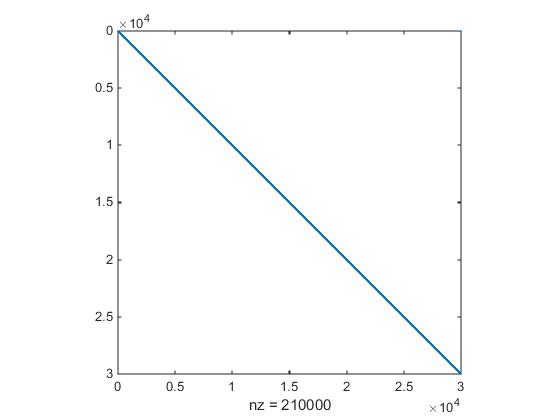Large Sparse Quadratic Program with Interior Point Algorithm
This example shows the value of using sparse arithmetic when
you have a sparse problem. The matrix has n rows,
where you choose n to be a large value. A full
matrix of size n-by-n can use
up all available memory, but a sparse matrix presents no problem.
The problem is to minimize x'*H*x/2 + f'*x subject to
x(1) + x(2) + ... + x(n) = 0,
where f = [-1;-2;-3;...;-n].
Create the parameter
nand the utility matrixT. The matrixTis a sparse circulant matrix that is simply a helper for creating the sparse positive-definite quadratic matrixH.n = 30000; % Adjust n to a large value T = spalloc(n,n,n); % make a sparse circulant matrix r = 1:n-1; for m = r T(m,m+1)=1; end T(n,1) = 1;Create a sparse vector
v. Then create the matrixHby shifted versions ofv*v'. The matrixTcreates shifts ofv.v(n) = 0; v(1) = 1; v(2) = 2; v(4) = 3; v = (sparse(v))'; % Make a banded type of matrix H = spalloc(n,n,7*n); r = 1:n; for m = r H = H + v*v'; v = T*v; endTake a look at the structure of
H:spy(H)

Create the problem vector
fand linear constraint.f = -r; % linear term A = ones(1,n); b = 0;
Solve the quadratic programming problem with the
interior-point-convexalgorithm. Set theStepToleranceoption to a very low value so that the algorithm does not stop too early.options = optimoptions(@quadprog,'Algorithm','interior-point-convex','StepTolerance',1e-15); [x,fval,exitflag,output,lambda] = ... quadprog(H,f,A,b,[],[],[],[],[],options);View the solution value, number of iterations, and Lagrange multiplier associated with linear inequalities:
fval,output.iterations,lambda.ineqlin fval = -3.1331e+10 ans = 6 ans = 1.5000e+04Since there are no lower bounds or upper bounds, all the values in
lambda.lowerandlambda.upperare0. The inequality constraint is active, sincelambda.ineqlinis nonzero.On many computers you cannot create a full
n-by-nmatrix whenn= 30000. So you can run this problem only using sparse matrices.